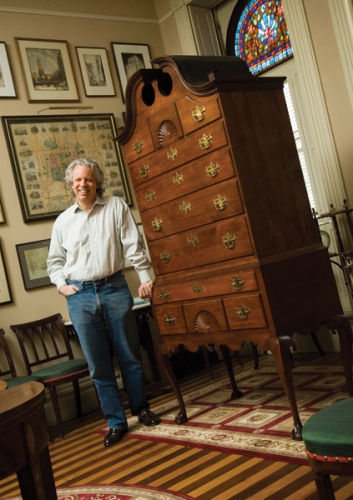Style & Shopping
On the Road Again
One local antiques dealer is gearing up for yet another season of broken hearts on a popular TV series.
When J. Michael Flanigan’s relatives visit his 1880’s antiques-filled Bolton Hill residence, finding a place to sit among his treasure trove of museum-quality antiques can be a daunting task. “I have an uncle who’s a priest, and every time he comes over he’s afraid to sit down,” laughs the 52-year-old Flanigan. “On Christmas Eve he came over, and I had this rocker I was going to take out of the room because I didn’t want anything to happen to it, but my uncle sat on it. Then he looked at me and said, ‘Wait, don’t tell me. I shouldn’t have sat here.’ I said, ‘Well, it only belonged to President Kennedy and came from his private bedroom!'”
Anyone else might seem off their rocker for making such a claim to furniture fame, but for Flanigan, it’s just another day at the office. The Baltimore-born antiques collector and dealer has appeared as an appraiser on PBS’s Antiques Roadshow for every one of the series’ 11 seasons. And in between Road trips, he’s carefully assembled an impressive collection of rare and interesting pieces, including a handsome 18th-century walnut and white pine Highboy, a pair of early 19th century Liberty of London “Thebes” stools, and photographs by world-renowned Baltimore Sun photographer A. Aubrey Bodine.
Flanigan actually fell into the antiques business serendipitously. “It was all a woman’s fault,” he says. “I was dating someone, and her family was interested in antiques. I didn’t know what to do one summer, so I just started knocking on doors looking for work in antique shops. And here I am 30 years later.”
After briefly working for a small shop along Antiques Row in Cockeysville in his early 20’s, Flanigan landed an informal apprenticeship at the venerable J.W. Berry & Sons which did conservation work for The Walters Art Museum, The Baltimore Museum of Art, and The Maryland Historical Society. He paid his dues by sweeping floors and driving the owner around town, and in return, was allowed to get his hands dirty by taking pieces apart. “And I don’t mean you just took out a drawer,” he says. “You really took it apart, and if you had to fix something, you had to see how it was made. I loved that. If you went to a museum you could only see something from a distance, but there I got to touch everything. It was a great education.”
Thanks to that education—as well as his made-for-TV appearance, resonant voice, and penchant for storytelling—Flanigan will preside over the furniture table when Antiques Roadshow rolls into the Baltimore Convention Center on June 16. And if this show is like any of the others, he’ll see “a couple hundred” objects in his 12 hours on the floor. It’s hard work, but it’s a role he relishes.
“Quite simply, Michael is brilliant,” says Roadshow Executive Producer Marsha Bemko. “He’s a very knowledgeable guy. The secret to knowing antiques is so many years of looking and touching—there’s no substitute for experience. Michael was a cabinetmaker in his journey through life, and all that experience adds up to being able to recognize different objects at a glance. Michael is also a great storyteller who is really comfortable on camera. He’s comfortable with what he’s talking about, and he really adores what he’s doing.”
It shows through, as when Flanigan discusses his favorite part of working on the show: the stories he’s heard. “I was once talking to a policeman, and I asked him, ‘Why do you stay a policeman?’ He said, ‘It’s a delicate balance between the horror and the comedy. You see people at their worst, and you see people at their best.’ While working on Roadshow is not as noble as all that, people tell stories that will make you laugh and will break your heart. The objects are the focus of the human drama.”
And everyone, Flanigan has learned in his time on the air, has a different motivation for showing up. “If someone comes to Roadshow, and they want me to tell them how smart they are for owning a particular piece, it’s probably not going to be a good experience for them,” says Flanigan matter-of-factly. “Ninety percent of the objects we see on the show are worth less than a hundred dollars. On the other hand, if they come in and they want to learn something, chances are I’m going to be able to help them. I can tell them everything they want to know.”
Not to mention a few things they’d probably prefer not to hear. “People come with these stories like ‘This came in on the Mayflower,'” he says. “You think, ‘This never saw the centennial of the Mayflower let alone the bicentennial of the Mayflower!’ But it doesn’t even take a generation for these stories to become conflated. And they all follow Flanigan’s Law, which is: Objects gravitate to the most famous person they can find in their history.”
For Flanigan, though, it’s the pieces themselves that deserve the fame. “A great piece stands out to me like a movie star does in a room of extras,” he says. “It has presence and, one hopes, with thirty years of experience, I can recognize that. The Roadshow is just American Idol for objects. My job is mostly to play Simon and say, ‘No.’ But then a star walks in, and I just applaud.”
